Abstract
The underlying motivation of this study is to account for the spatial variation of factors affecting women’s access to land, which has been largely ignored by the traditional regression-based model studies, much to the detriment of spatially varying relationships. Using household and individual-level data from the Demographic and Health Surveys (DHS), this study used Geographically Weighted Regression to explore and analyze the spatial relationships between women’s access to own or family land and determinants that influence women’s access to land in Africa. The results demonstrated that HIV-positive women in West Africa and Ethiopia were more likely to have access to own land than family land. Educated women in North, West and Southern Africa were less likely to have access to own land than their non-educated counterparts. Population density exhibited predominantly negative influence over women’s access to both own and family land. The relationship between rural areas and women’s access to their own land was mostly not significant across the continent. However, both rural and urban women in West Africa and Ethiopia were negatively associated with access to family land. Women within the 15–24 age group in West, Central and East Africa were more likely to have access to own land than family land, while those within the 25–34 and 35–49 age groups had a better chance of gaining access to family than own land, with the results being significant in Southern, West and North Africa. While some of the reasons for these variations have been discussed in this paper there is still need for further investigation particularly focusing on smaller regions since this study shows that women’s access to land changes as one crosses geographical boundaries even within the same country.
1. Introduction
At the center of most African economies is agriculture, which employs 65 percent of Africa’s labor force and accounts for 32 percent of the continent’s Gross Domestic Product (GDP). This domination of agriculture suggests the importance of land as a basic tool of development, livelihood and a significant determinant of income earning power and therefore a question of fundamental human rights. A World Bank study pointed out that women are at the core of the agriculture sector in Africa, providing between 60 and 80 percent of total agriculture labor and producing more than 80 percent of food for both household consumption and for sale. Despite women’s central role in economic production, attaining food security and meeting family nutritional needs, women in Africa own less than one percent of the land in the region [1,2] and continue to face discrimination in accessing and owning land.
Within the literature, several socioeconomic and demographic factors have been identified as key determinants affecting women’s access to land in Africa. These include marital status [3,4,5], age, level of education [6,7,8], place of residence (rural/urban), wealth class [9,10], number of children, and monogamous/polygamous relationships. Many studies also indicate that population density and the HIV epidemic also play an important role. One common assumption at the center of these studies—and with regression modeling in general—is that the relationship between women’s access to land and its determinants is globally constant across the extent of the modeled population or study area. In some cases this is appropriate, but in others spatially static model parameters serve to obscure local heterogeneity. When that variation is great, this can lead to misleading results and may be counterproductive when adopted for addressing policy issues that have a wider impact such as women’s access to land.
To address this weakness, statistical geographers [11,12] came up with Geographically Weighted Regression (GWR)—a geographically non-stationary modeling technique designed to explore spatial heterogeneity in geographic datasets. GWR elucidates the local variation that would otherwise be obscured by a global model. GWR is a particularly salient technique for this study since the relationship between women’s access to land and its determinants is clearly non-stationary. For example, the relationship between women’s access to land and level of education is likely to vary from one region to the next since access to and availability of educational resources differ as one crosses geographic boundaries.
Accordingly, the primary objective of this study is to use GWR to explore and analyze the spatial relationships that exist between women’s access to land in Africa and some of its determinants, which include, marital status, age, level of education, place of residence (rural/urban), wealth class, number of children, monogamous/polygamous relationships, population density and the HIV epidemic. Such analysis will be conducted within a single framework and the results visualized on a series of choropleth maps. Moreover, GWR will be used for diagnosing patterns or patchiness that may be otherwise undetectable and for isolating and defining geographically contiguous areas where women’s access to land-determinant relationships remain relatively constant. Overall, the underlying motivation of this study is to account for the spatial variation of factors affecting women’s access to land, which has been largely ignored by the traditional regression-based model studies, much to the detriment of spatially varying relationships.
2. Experimental Section
2.1. Geographically Weighted Regression
Because readers may not be familiar with the details of GWR, a brief explanation is offered here. It is by no means comprehensive. For much more detail and a better understanding of the statistical foundations of GWR, please see [11,12,13,14] and presented with examples by [15].
The basic idea behind GWR is to treat the regression coefficients as functions of location instead of fixed constants. The location is defined by the coordinates of each sample point or polygon centroid in the case of areal data. The result is a model shown in Equation (1).
where y is the dependent variable, α is the intercept, χ is the independent variable, β is the coefficient of the independent variable, ε is the error term, and (u,υ) captures the coordinate location of either a sample point or polygon centroid.
Instead of calibrating a single regression equation, GWR uses Equation (1) to generate separate regression equations for each observation, with a search window also known as a spatial kernel, determining which neighboring observations are included in the calibration of each individual regression. The spatial kernel also determines how the neighboring observations are weighted based on a Gaussian distance decay, bi-square or tri-cube function. These functions give most weight to the observations that are closest to the one at the center. This is based on the assumption that points/observations nearby one another have a greater influence on one another’s parameter estimates than points/observations farther apart (Tobler’s Law).
This immediately raises a question—what area should the spatial kernel cover each time? The answer is provided by a process of calibration to select an “optimal” bandwidth (an optimal search window size). Choice of the bandwidth can be very demanding, as n regressions must be fitted at each step. An adaptive or fixed size kernel can be used to determine the number of local observations that will be included in the bandwidth, depending on the spacing of the data. However, most studies favor adaptive kernels where if the number of neighbors within the search window is fixed then it will vary in area from observation to observation: where the sample observations are close together the window will have less area; where the observations are sparse it will fill a greater area.
Because the regression equation is calibrated independently for each observation, a separate parameter estimate, t-value, and goodness-of-fit is calculated for each observation. These values can thus be mapped, allowing the analyst to visually interpret the spatial distribution of the nature and strength of the relationships among explanatory and dependent variables.
2.2. Study Region and Data
The analysis for this study is based on household and individual-level data from the Demographic and Health Surveys (DHS). The DHS data analyzed in this report are drawn from surveys between 1999 and 2013/201414 [16] across 34 countries in Africa (see Figure 1).
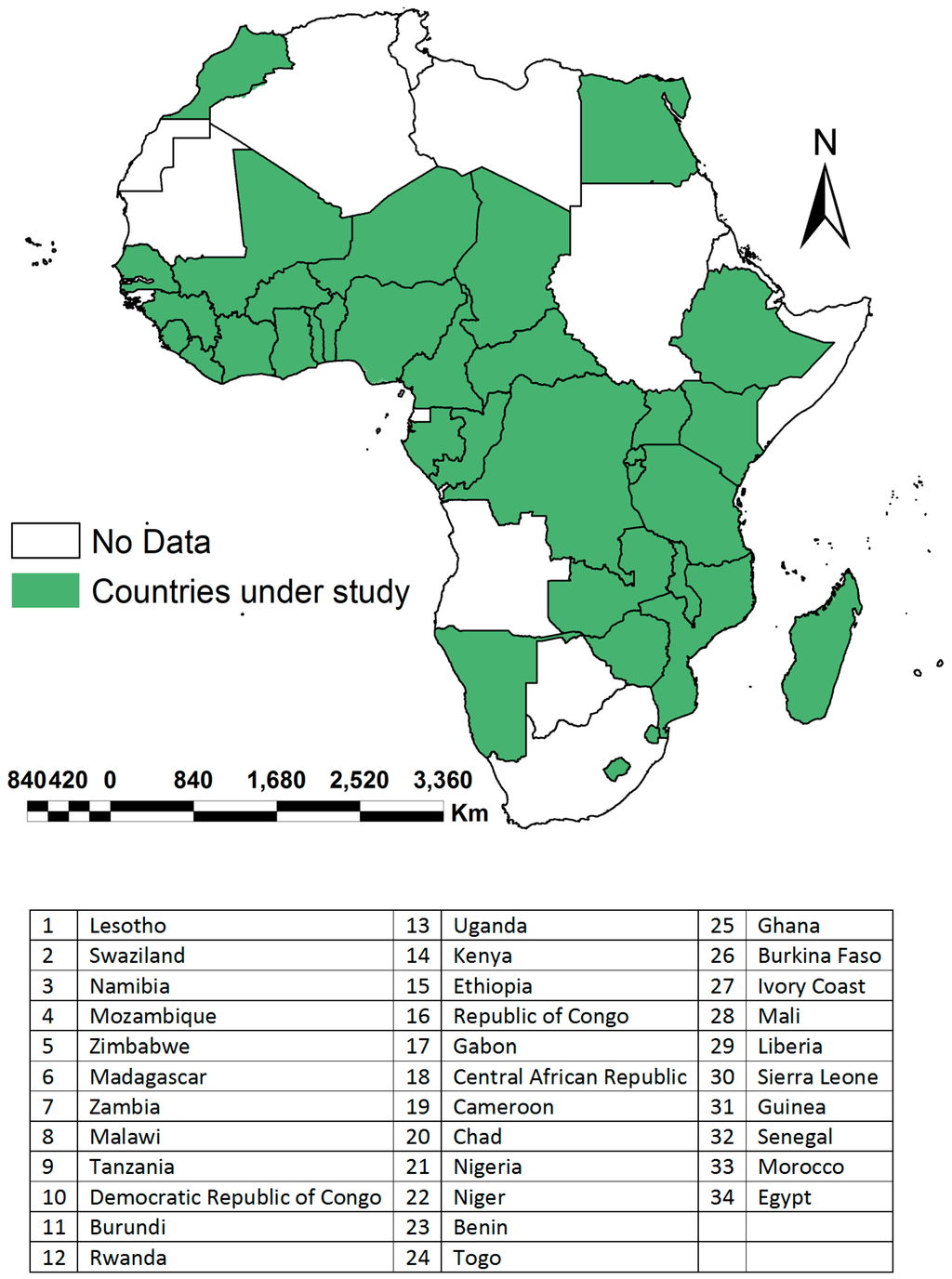
Figure 1.
Study area.
The DHS is an ideal vehicle for studying the linkages between women’s access to land and the context in which it takes place. In the DHS, women of age 15–49 who stayed in the household the night before the interview and who meet the survey eligibility criteria are eligible to be interviewed. Women are asked about the type of land they have access to and their responses are grouped into four categories: Own Land, Family Land, Rented Land and Someone Else’s Land. The first category “Own Land” refers to women who have access to land they own individually. The second category “Family Land” refers to women who have access to land owned by the whole family, family member or one which they own jointly with a family member, e.g., partner/husband. The third category “Rented Land” refers to women who access land which they pay for on a lease basis but does not belong to a family member. The fourth category “Someone’s Else’s Land” refers to women accessing land for free, which belongs to someone who is not a family member. In addition, the DHS also collects data about these women and their partners/husbands on a range of socioeconomic and demographic indicators, including information on age, marital status, level of education, wealth class, number of children, number of wives of partner/husband, and area of residence etc. With this information, it is possible to describe the type of land women have access to as well as the socioeconomic and demographic characteristics of these women. Furthermore, since late 1996, the DHS has consistently recorded the geographical location of each cluster of surveyed households with handheld Global Positioning Systems (GPS) units. This information now allows researchers to link DHS determinants and a spatial region/location thereby allowing the opportunity to account for the spatial variation of factors affecting women’s access to land. Because of the GPS units, data in this study were linked to administrative levels/regions within countries under study and these regions are shown in Figure 2 and their respective names can be found in Appendix.
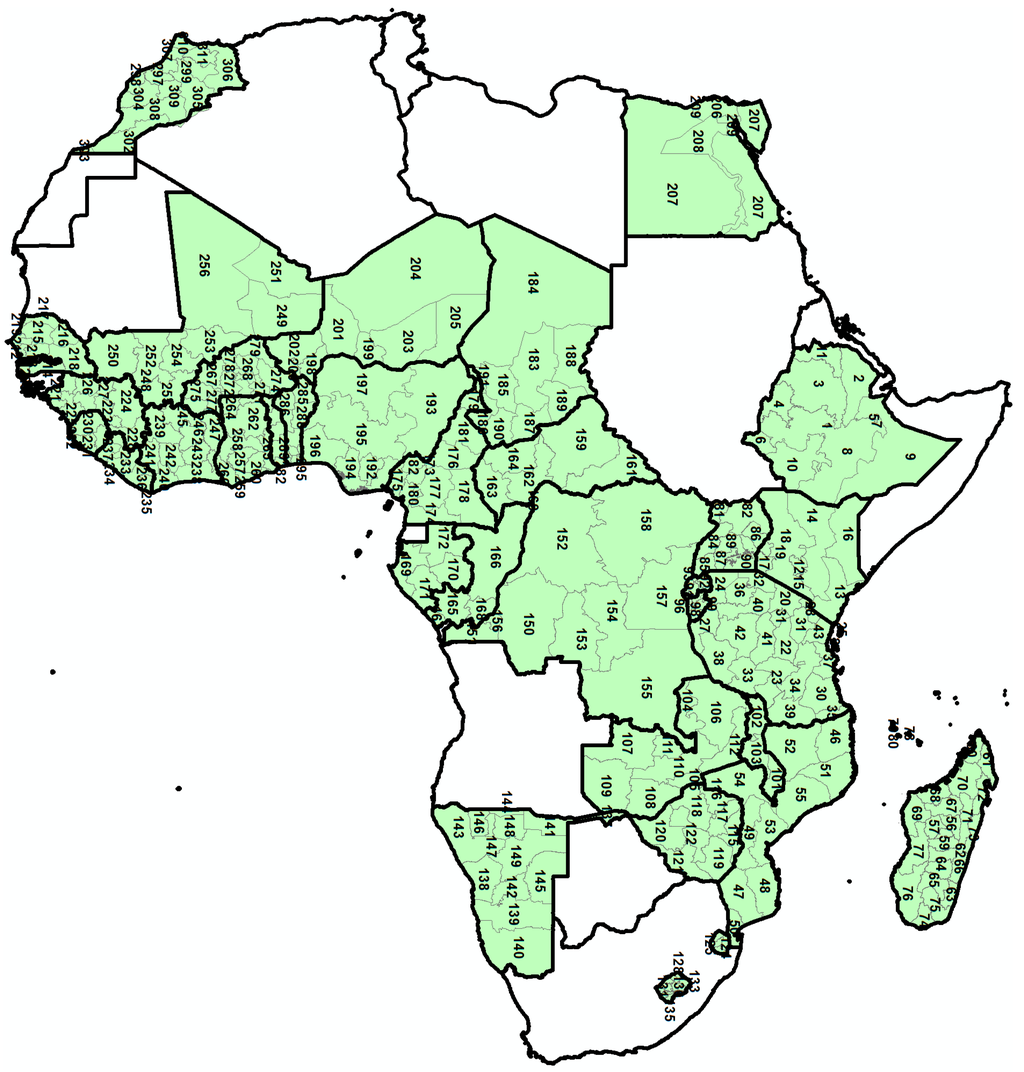
Figure 2.
Study area at the DHS administrative level.
For this study, the survey datasets were pooled together to form one dataset on women’s access to own and family land along with data on the same socioeconomic, demographic, and health characteristics of the women interviewed. This was possible because the DHS surveys are carried out in a standardized form, with the same list of socioeconomic and demographic characteristics. By pooling the data from different survey years for each country, a larger sample for each country was obtained, thus increasing the statistical power of the analysis. Table 1 gives a breakdown of the survey and sample characteristics of the data used in the study. Because of large differences across country populations and sample sizes, the sample weights in the pooled dataset needed to be rescaled to represent the 34 countries in proportion to their populations. An expansion weight was calculated for each country and then multiplied by the original sample weight. The weights were then renormalized to average to one across the pooled sample. The new weights were applied in the analysis.

Table 1.
Survey characteristics of the data.
2.3. Methodology
In this section, the Ordinary Least Squares (OLS) and GWR spatial statistical tools were employed to explore the spatial relationships between women’s access to land (the dependent variable) and eight predictors or independent variables that include marital status, age, level of education, place of residence (rural/urban), wealth class, number of children, monogamous/polygamous relationships, population density and the HIV epidemic. For an in depth analysis, the dependent variable was divided into two: (1) women’s access to own land; and (2) women’s access to family land, while maintaining the same predictor variables. The dependent variables were the documented number of women (as a percentage) who had access to own or family land by district level in each country. The independent variables with the exception of population density were also measured as a percentage of the total number of women interviewed. Population density was measured in square kilometers.
The global OLS model was mainly computed to act as a diagnostic tool for selecting the appropriate predictors with respect to their strength of correlation with the dependent variable. In this respect, OLS was used to check for redundancy or multi-collinearity among the predictors. In regression analysis, and particularly in GWR, strong multi-collinearity can impair the model and produce artificial and erroneous effects. Although multi-collinearity can never be entirely ruled out, there are a few ways to test for this phenomenon. For this study, multi-collinearity was assessed with the Variance Inflation Factor (VIF) values of the OLS. As a rule of thumb, predictor variables with VIF values larger than 7.5 were removed (one by one) from the OLS model and re-calibrated.
After accounting for multi-collinearity among the variables, a GWR model was constructed. Since GWR is a sample-point-based technique, the predictor variables associated with women’s access to land in each geographic region in Africa were assumed to be samples taken at the centroid of that region so that the point i is defined as the centroid of a geographical region. GWR was carried out using GWR4, a Microsoft Windows-based application software for calibrating GWR models [12,17,18]. Based on the assumption of spatial autocorrelation, a spatial weights matrix was constructed within the local GWR model, in which the observations were influenced by the surrounding observations. The extent of this influence was inversely related to distance. The weights were calculated using the Bi-square kernel, an adaptive spatially varying kernel, which ensures that the size of the kernel shrinks in areas where observations are densely distributed and expand in sparsely populated locations. The optimal size of the kernel or optimal number of nearest neighbors, also known as the bandwidth of the kernel was computed using cross-validation (see [19,20] on how cross-validation works).
Output from GWR model included locally varying parameter estimates and t-values, which were mapped on choropleth maps in ArcGIS to visually interpret the spatial distribution of the nature and strength of the relationships between the independent explanatory variables and women’s access to own or family land (the dependent variables). In addition, the GWR model provided goodness-of-fit measures to act as diagnostics for the model.
3. Results and Discussion
The summary diagnostic results of the GWR models are listed in Table 2. The results indicate that both models were well specified, explaining approximately 78.8% and 75% (see the adjusted R-Squared values in Table 2) of the variation in women’s access to own and family land, respectively. Comparing the models using their Akaike Information Criterion (AICc) values, Table 1 shows that the model for family land had a better fit when compared to the one for own land since its AICc value was lower by 21.079.

Table 2.
Summary of GWR diagnostic statistics.
The other output of fundamental merit from the GWR model is its ability to simultaneously display and visualize both the parameter estimates and significance of each explanatory variable on either a choropleth map or raster surface. This makes the complex relationship that varies over space easier to comprehend. In this study, choropleth maps were used to show that there is a spatial variation in the relationship between the dependent variables (own land and family land) and the explanatory variables of education, marital status, age, wealth class, number of children, monogamous/polygamous relationships, place of residence, population density and the HIV epidemic across Africa. The choropleth maps showing the parameter estimates of the explanatory variables are shown in Figure 3, Figure 4, Figure 5, Figure 6, Figure 7, Figure 8, Figure 9, Figure 10, Figure 11, Figure 12, Figure 13, Figure 14, Figure 15, Figure 16, Figure 17, Figure 18, Figure 19 and Figure 20. For each map, a 90% significance threshold was used to mask out all areas in which the relationship between the dependent variables (own land and family land) and explanatory variables was not significant. In this study, it was implied that distinguishing between positive and negative parameter estimates (and associated t-values) in these areas was unnecessary. These areas were deemed to be of less interest to an analyst than those areas that were significant. Within the significant areas, there was evidence of both positive and negative relationships. Positive values highlight areas were an increase in the explanatory variables results in an equally increase in the chances of women in that region having access to either their own land or family land. On the other hand, negative values imply that a decrease in the explanatory variables results in an equally decrease in the chances of women in that region having access to either own land or family land. Consequently, the results of the spatial distribution exhibited by the variables under study in relation to women accessing own land or family land are analyzed and the possible reasons behind the distributions are discussed in the following sub-sections.
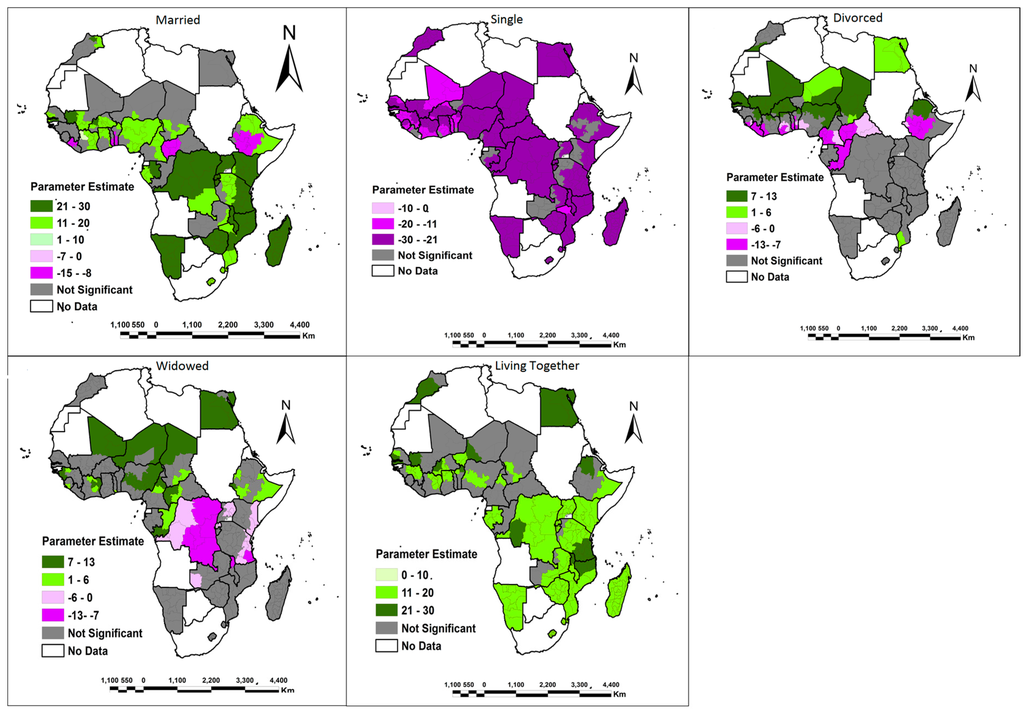
Figure 3.
Spatial distribution and significance of marital status on women’s access to own land.

Figure 4.
Spatial distribution and significance of marital status on women’s access to family land.
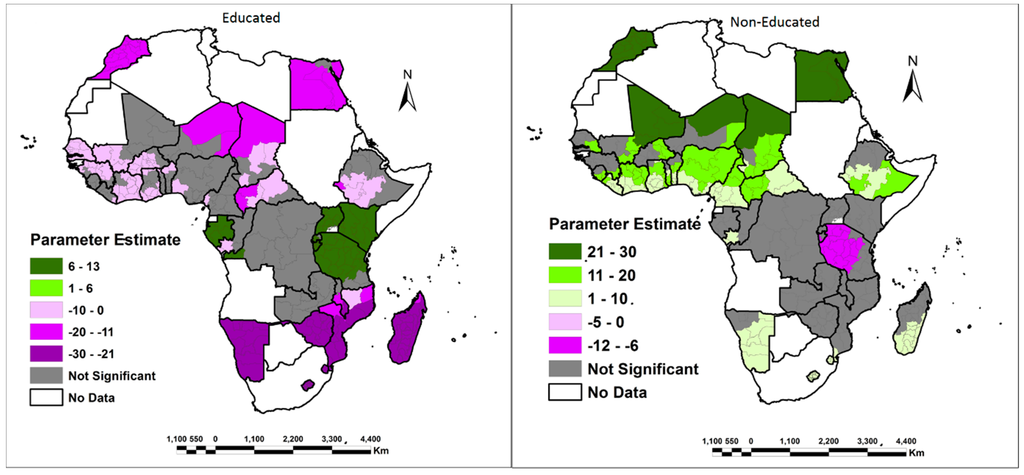
Figure 5.
Spatial distribution and significance of education on women’s access to own land.
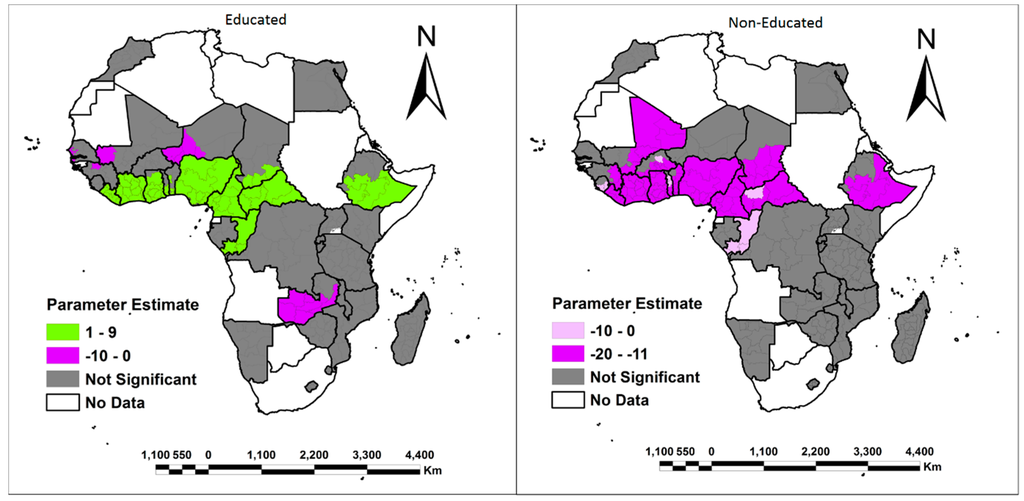
Figure 6.
Spatial distribution and significance of education on women’s access to family land.
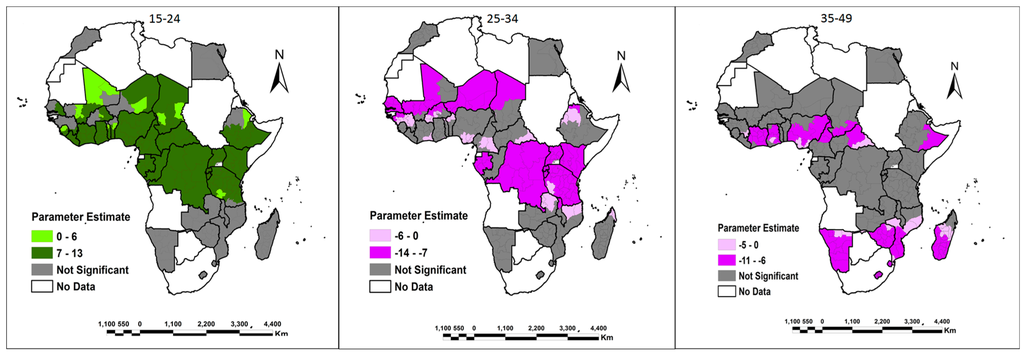
Figure 7.
Spatial distribution and significance of age on women’s access to own land.
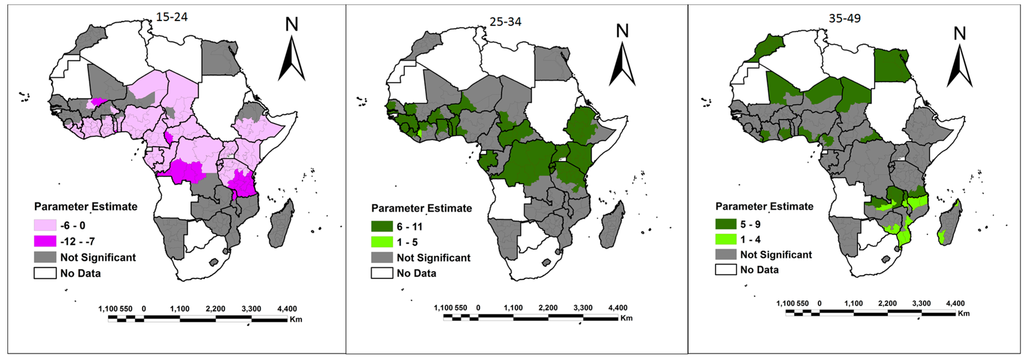
Figure 8.
Spatial distribution and significance of age on women’s access to family land.
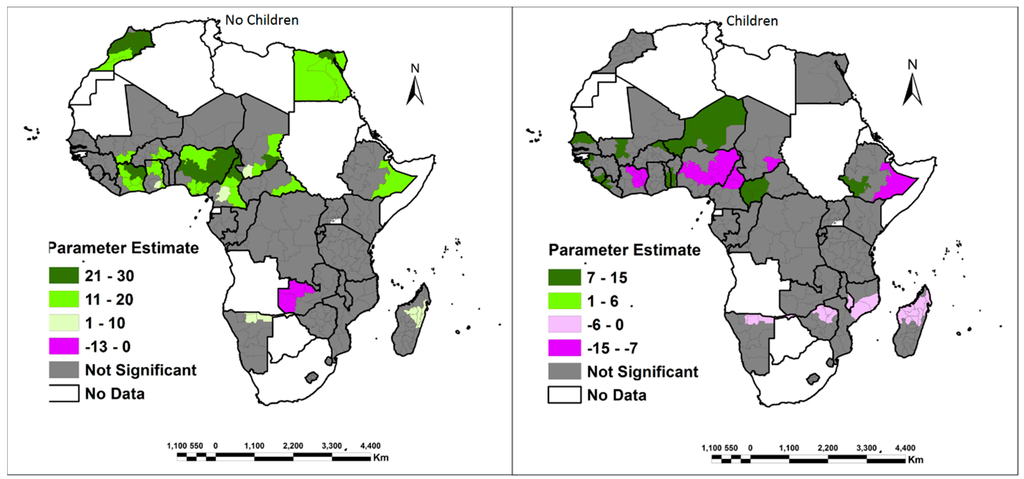
Figure 9.
Spatial distribution and significance of children on women’s access to own land.
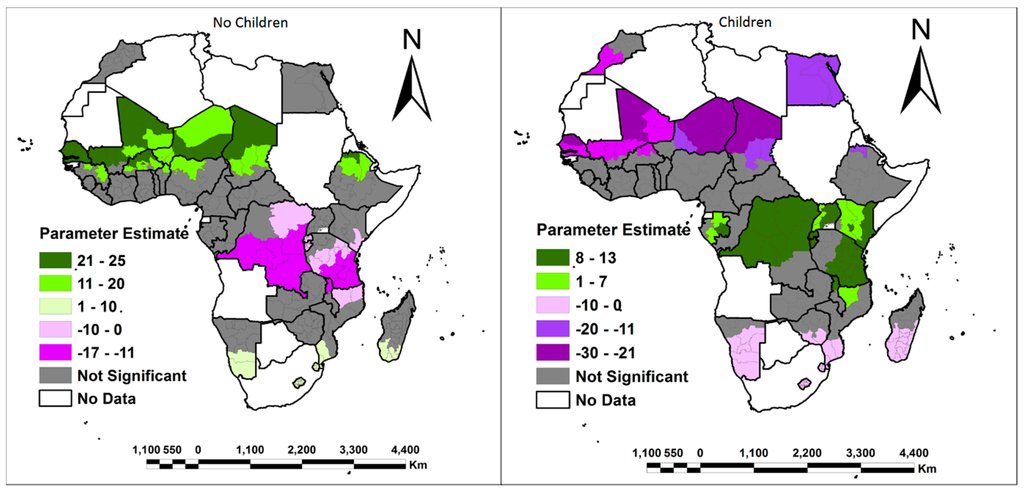
Figure 10.
Spatial distribution and significance of children on women’s access to family land.
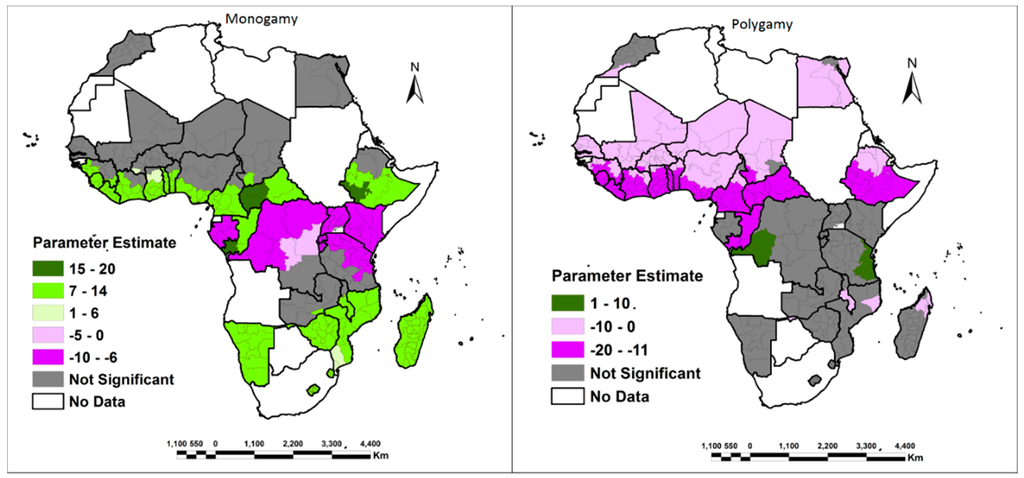
Figure 11.
Spatial distribution and significance of monogamous/polygamous relationships on women’s access to own land.
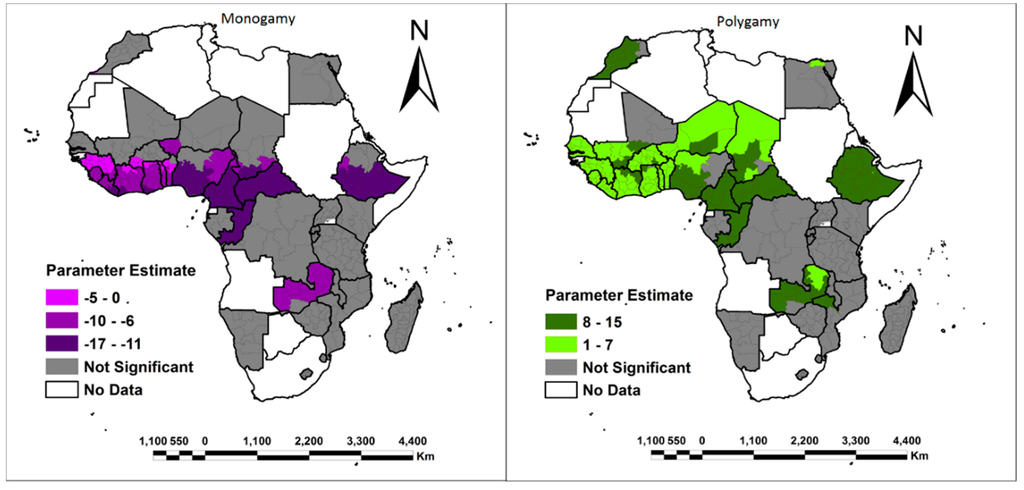
Figure 12.
Spatial distribution and significance of monogamous/polygamous relationships on women’s access to family land.
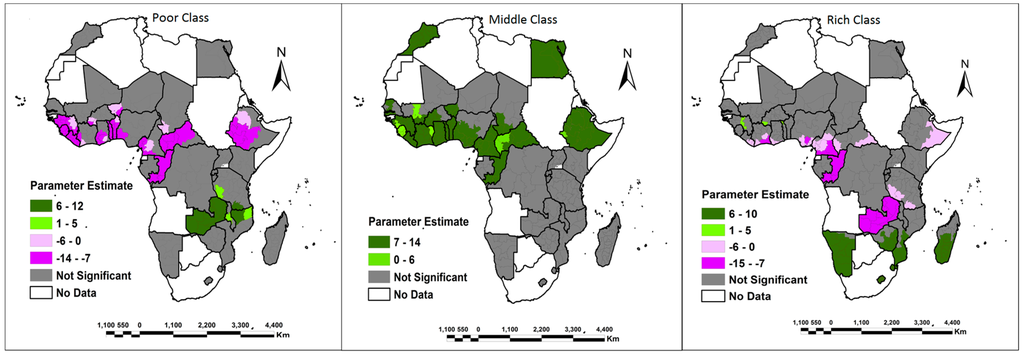
Figure 13.
Spatial distribution and significance of wealth class on women’s access to own land.
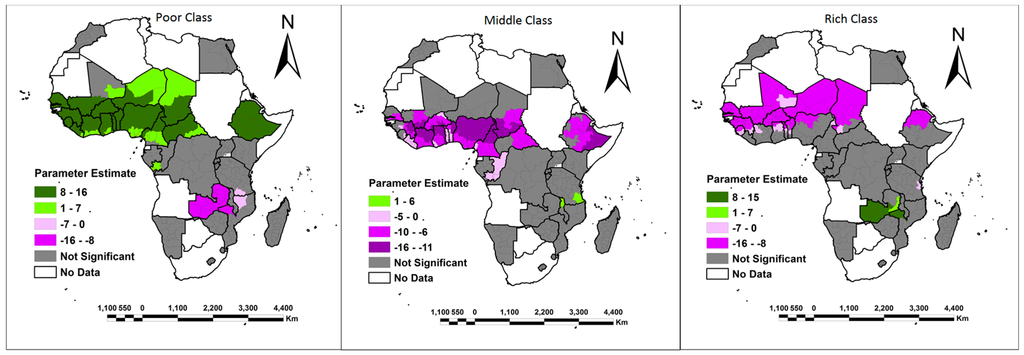
Figure 14.
Spatial distribution and significance of wealth class on women’s access to family land.
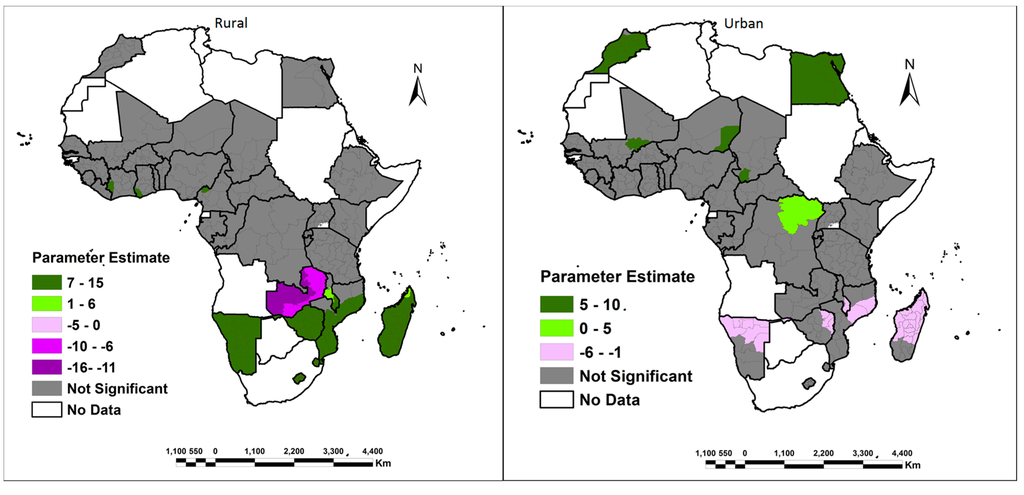
Figure 15.
Spatial distribution and significance of place of residence on women’s access to own land.
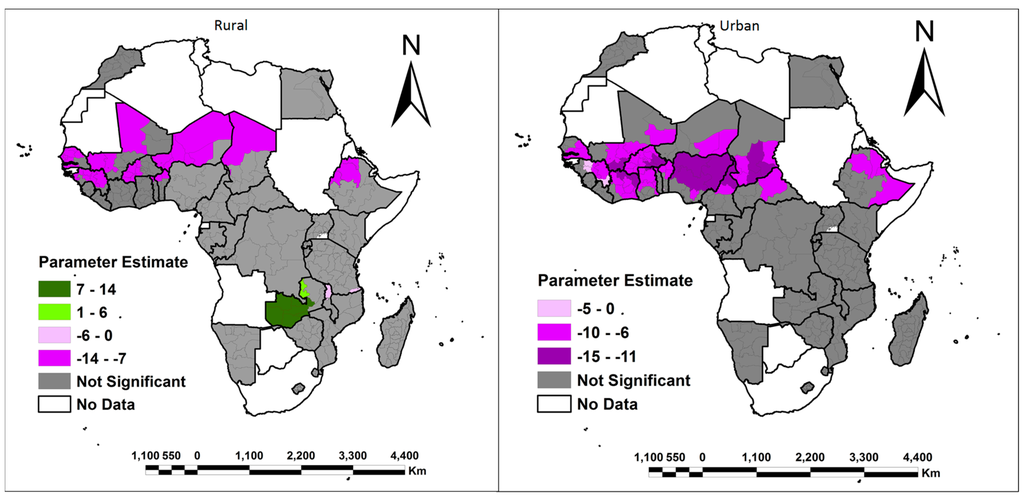
Figure 16.
Spatial distribution and significance of place of residence on women’s access to family land.
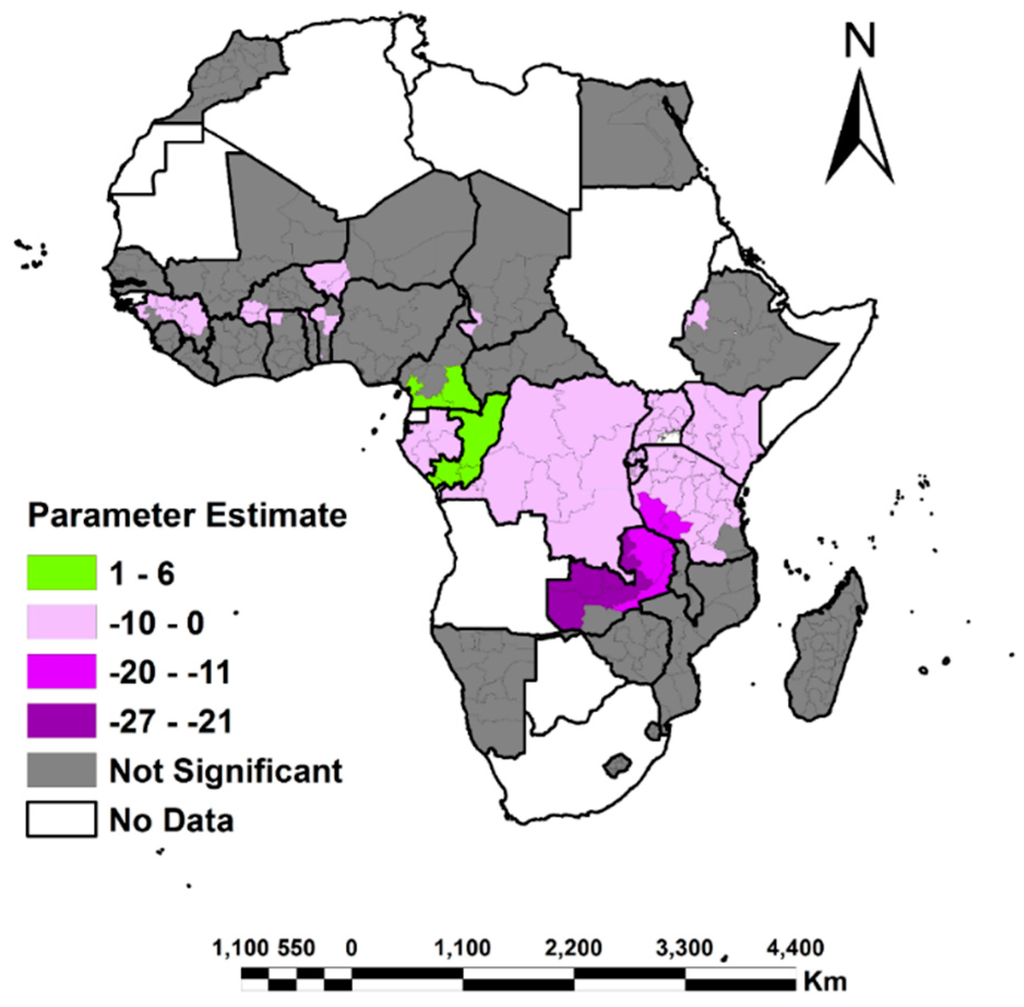
Figure 17.
Spatial distribution and significance of population density on women’s access to own land.
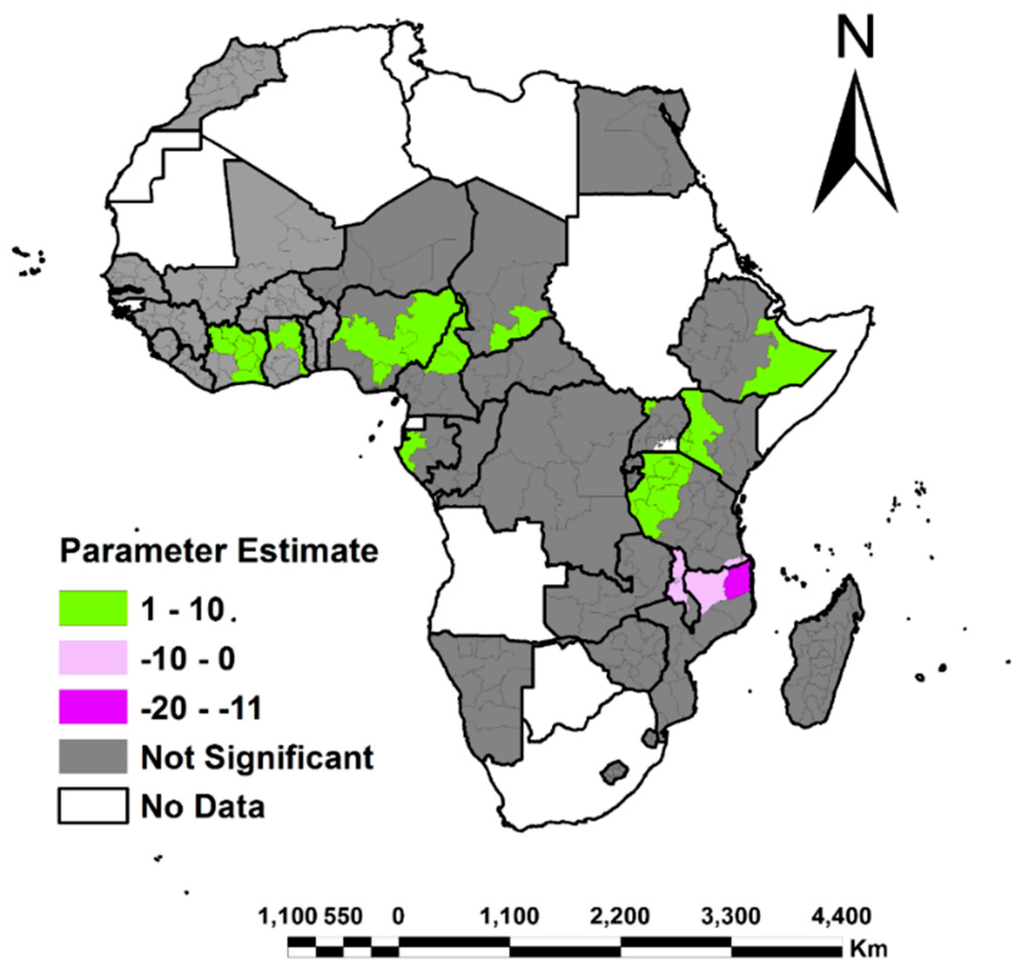
Figure 18.
Spatial distribution and significance of population density on women’s access to family land.
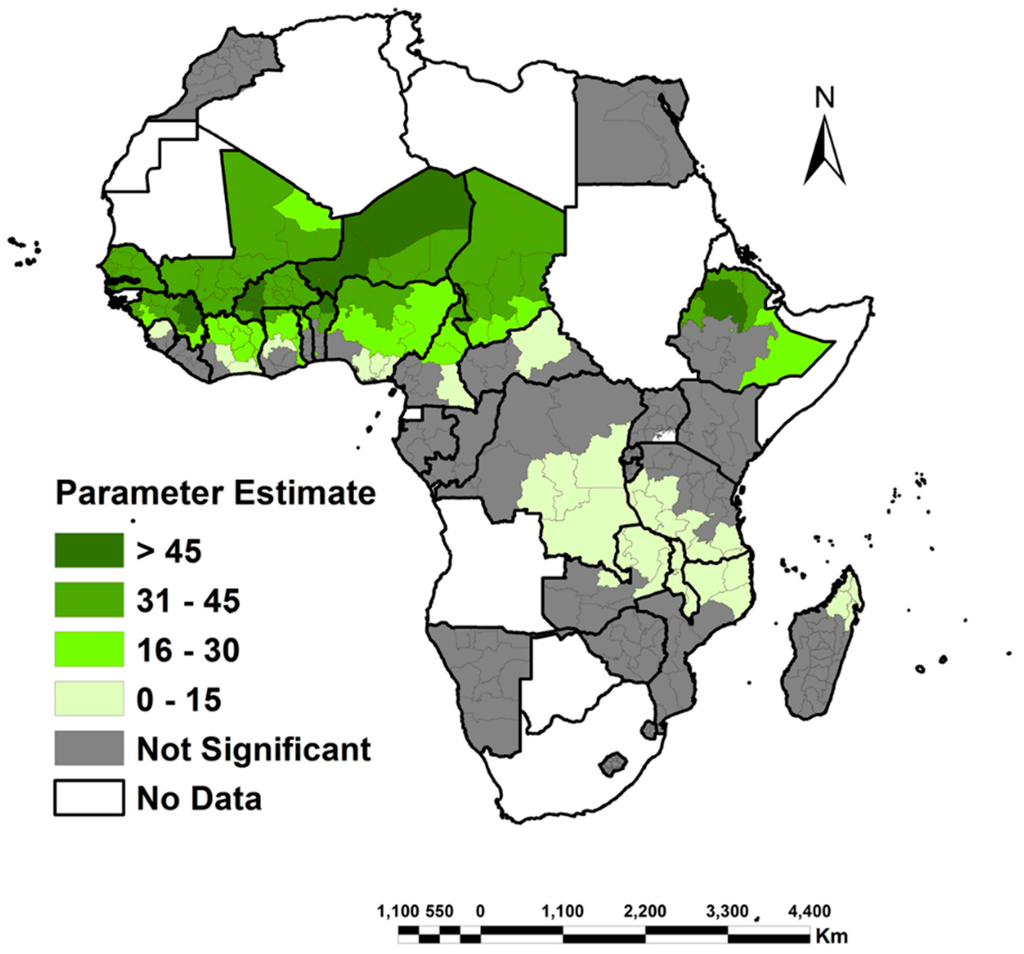
Figure 19.
Spatial distribution and significance of HIV on women’s access to own land.
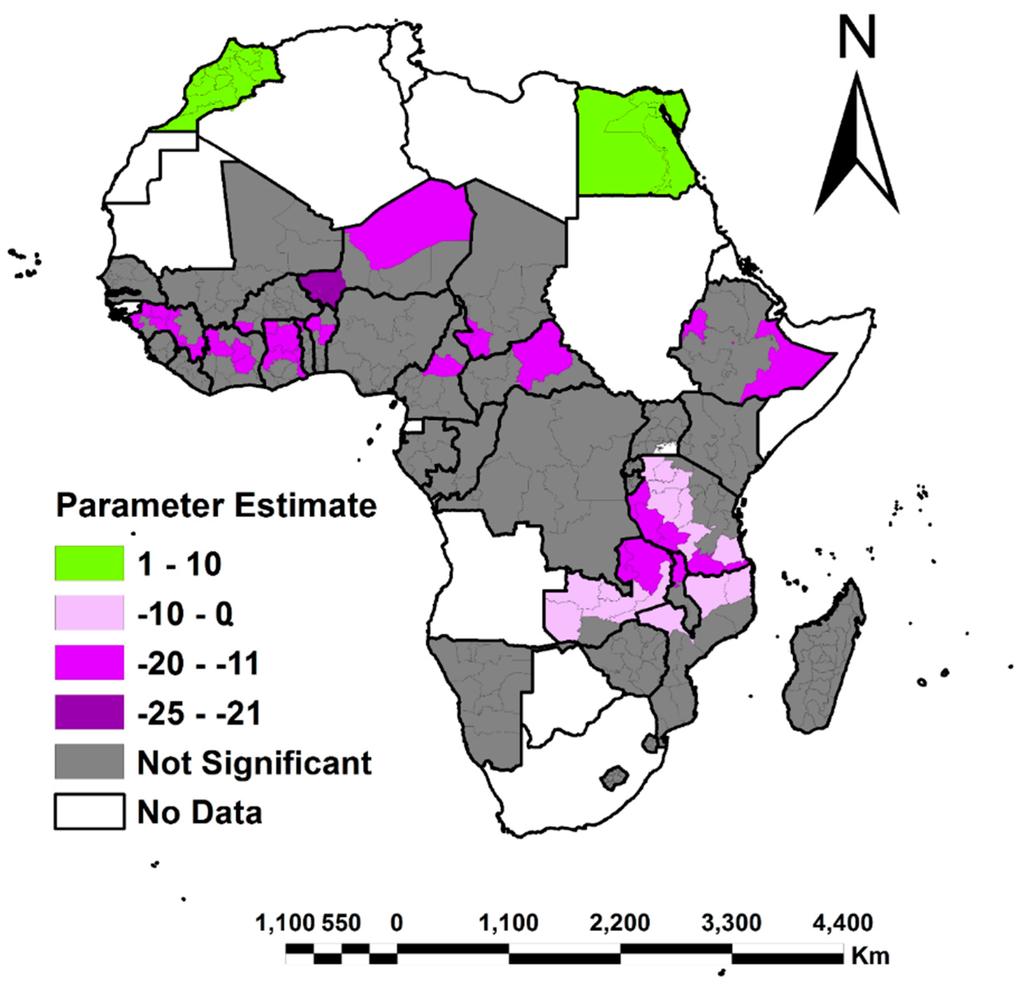
Figure 20.
Spatial distribution and significance of HIV on women’s access to family land.
3.1. Marital Status
Figure 3 and Figure 4 illustrate the spatial distribution and significance of marital status on women’s access to own and family land. Analysis of the Figures indicates a positive association between married women in West Africa and access to family land. This could be attributed to the fact that as wives, custom dictates that married women are granted a portion of their husband’s land (which falls into the category of family land) and have both the right and the obligation to cultivate it [3,4]. Evidence from the literature also suggests that in some cases where the husband is unwilling to provide access to land, married women in Burkina Faso, have been known to demand land from the husbands’ lineage [21]. At the same time, married women in regions RSI, RSII and RSIII in Central African Republic had a strong negative association with access to own land mainly due to legislative barriers that inhibit them from owning land in their own right because, according to [22], they are regarded as minors or chattels with secondary rights derived through their membership in households and secured primarily through marriage. The results also displayed a positive relationship between married women in Central, East and Southern Africa with access to own land. These women might be benefitting from what are called tokens, a tradition that dates long back where husbands give wives small pieces of land in appreciation of the labor they provide on the husband’s farms. Although the tokens are small pieces of land they do provide these women with access to their own land where they grow crops of their own choice [23].
Although marriage provides some security to access to land for some women, it usually only lasts as long as the woman remains married. If a couple divorces, a woman is expected to leave the homestead empty-handed and farm with her own family. This study showed that in contrast, divorced women in West Africa and parts of North Africa (for example Egypt) were positively associated with both family land and own land. This is a direct result of divorced women benefiting from legislation giving equal rights to spouses during the conclusion, duration and dissolution of marriage, and requires equal division of all assets (including land) between husband and wife upon divorce, although adoption of this law is not uniform across all countries [5]. An additional way these divorced women could be accessing land is through their fathers or other male relatives such as brothers or uncles when they go back to their place of birth. Within the literature the same view is shared by [24], who point out the significance of a woman’s right to return to her birth family and be given temporary rights to use land to produce food for herself and her children [24] also adds how this tradition which is still intact in Senegalese marriage norms is helping returning daughters access land despite population pressure, land scarcity, changing marriage practices and increasingly commercialized and intensive agricultural development. As for widows, results in this study were contrasting. On the one hand, they had a positive association with access to land, for example, in West Africa and Southern Africa. This could be because widows generally inherit their deceased husbands’ land to hold on behalf of their children (mainly sons) to whom it would be distributed later, though this is not always the case. For those widows who return to their place of birth, their access to family land would be most likely through male relatives just like in the case with divorced women. For widows in Central, East and parts of West Africa who were negatively associated with access to land, they most likely lose the rights to land following the death of their spouse as they have virtually no tenure or inheritance rights, for example in Tanzania and Zambia. Silaa et al. [25] and Nyakoojo et al. [26] support these findings in their research reports commissioned by the Eastern African Sub-Regional Support Initiative for the Advancement of Women (EASSI) on women’s land rights in Tanzania and Uganda as both refer to cases encountered during the research where widows reported losing their land to their husband’s relatives after his death. In addition, research carried out in Burundi, a country where 25 percent of women are widows, revealed that although customary law traditionally grants widows a lifetime use-right, that custom is fading given increasing land pressures by a growing population. Furthermore, if in-laws permit a widow to stay on the land, she has no right to sell the land. Widows who are permitted to use in-law family land are vulnerable to land-grabbing by male relatives of the deceased husband, and childless widows or divorced women do not have rights to use their husband‘s land [27,28,29].
As far as single women are concerned, African society views their need for land as the least important among women’s marital status. They do not have dependencies; hence, they are seen as not in need of land. This is highlighted in this study by the strong negative association between single women and access to own land. In the very few regions they were positively associated with access to family land (Katanga, Kasai and Kivu in DRC, southern Tanzania, Niassa and Cabo Delgado in Mozambique and Northern Malawi), their mostly likely route of accessing land would be through their fathers, brothers or uncles, but upon marriage in patriarchal communities this access to land through relatives is lost, as they are expected to have access to land through their husbands. Another possible explanation supported by [30], is the availability of dormant land, which single women with the help of the local community are allowed to rent or purchase. This land is becoming available due to rural-urban migration, the impact of the HIV/AIDS epidemic which is wiping out families, as well as the death of adult male children thus forcing parents to change their inheritance practices by allowing their single daughters to inherit the land so as to keep it within the family or clan.
3.2. Education
According to [6], highly educated women are presumed to have more access to land since they are aware of their inheritance rights and can negotiate for their land rights in male dominated systems that are currently influencing land policy and reform in African society. In this study this was certainly true for educated women in East Africa (Tanzania, Rwanda, Burundi, Uganda and Kenya) and Gabon who were positively associated with access to both own and family land (Figure 5 and Figure 6).
However, the results in some regions, e.g. Southern Africa, Morocco, Egypt and West Africa, were counterintuitive; that is, educated women were negatively associated with access to land. This can be attributed to the fact that agriculture is often seen as an “employment of last resort” avoided by the educated especially those with secondary and tertiary education. Within the literature, this assertion is supported by [23,24] who point out that educated people often complain that agriculture is not attractive enough in terms of compensation and conditions of services compared to what other professions like law, medicine, or banking offer. In Zambia, for example, there are no benefits such as paid holidays or pension in the agricultural sector apart from your wage or salary. This significant counterintuitive effect of women’s education and access to land is also in line with the work of [31], which underlines that better-educated women are less involved in farming. Another study by [32] found that in Kampala, Uganda, most women involved in urban farming have only primary education, or none at all.
The results also highlighted how illiteracy is another barrier for women to access land, for example in West Africa and Ethiopia where non-educated women had a strong negative association with access to family land (Figure 6). In these parts of Africa, 55% of women on average cannot read or write. According to [7,8], illiteracy not only erodes women’s confidence to articulate their position on land related issues but can also mean that often women do not utilize their legal rights because they necessarily do not know their rights or do not understand the content of the law.
3.3. Age
The effect of age on one’s access to land is rarely discussed within the literature. However, it is clear that access to land is at least important to young people as it is to older adults. Figure 7 and Figure 8 show that young women aged 15–24 were more likely to have access to their own land than family land. This was significantly true for women in West, Central and East Africa. However, the results were not significant in Southern Africa. The negative link between young women and access to family land can be associated with a number of reasons. For example, in [33], a survey conducted among young farmers from about 800 organizations across Africa recognizes that inheritance is the main means by which young people obtain access to land. However, the subdivision of land among a large number of siblings leads to fragmented and unviable land parcels, and young people are increasingly left landless or as secondary right users. At the same time, life expectancy is increasing in many countries and young people have to wait longer to inherit their shares of family land. Adult smallholder farmers are often unwilling to pass on land while they are still alive, as they themselves rely on small parcels of land in the absence of pensions or social security systems. Opportunities to access land are even scarcer for young women. Though many developing countries are adopting statutory laws that grant women equal rights to land, customary laws continue to deny these rights in practice. Customary laws on inheritance frequently decree that land is passed from father to son, so women’s only avenue to land access is often through their relationships with male relatives. In another study in Zimbabwe and Kenya [34] also found that women’s ability to hold on to land or property in general was dependent on their social networks within the community, which younger women would not have had time to establish hence are more at risk of losing land tenure.
As for the positive association between young women in West Africa and Central Africa and access to own land, the author can only speculate that the chances of these young women accessing own land appear to be mediated more by wealth and confidence than by gender.
Figure 7 and Figure 8 also highlight the fact that middle aged (25–34) and older women (35–49) had a better chance of gaining access to family land than own land, with the results being significant in Southern, West and North Africa. A possible explanation could be that most African women in these age groups are married and so have access to land through their husbands, land which in this study was classed under family land. On the other hand, the negative association between older women and access to own land (Figure 7) can be linked to a number of reasons. African older women are often the poorest of the poor and face multiple discriminations across their lives: discrimination in education, employment, wages, and benefits all factor into their lack of power and violation of their rights. With poverty and disempowerment, older women face two main threats to their access to land: the first is through formal and customary laws that discriminate against them in their right to own property or inherit it; the second is land grabs through violence and intimidation. Since, in most African communities, women cannot hold title to property or inherit their property upon the death of a spouse, older women are often finding the opportunities to access land in jeopardy. This trend will continue since African women are living longer than their male counterparts and are disproportionately outliving their spouses. In addition, older women also face extrajudicial challenges to their security of tenure as far as accessing own land is concerned. Many of these threats and intimidations take the form of accusations of witchcraft, which provide license for property grabbing, violence, and even murder. These accusations are well documented in Tanzania and tend to increase with resource scarcity and incidentally, relieve older women of their land [35,36,37].
3.4. Children
Throughout history childless women have been negatively associated with access to land in African society. This was the case for childless women in Central and East Africa (Figure 9 and Figure 10). This is linked to the pronatalist cultural tradition of these regions where childless women are often seen as social deviants, rejected by partners, socially ostracized, resulting in loss of access to land or other productive resources. They also face questions on how they will accomplish the many tasks that go into agriculture without children considering the labor-intensive setting of farming in Africa. Mushunje [38] and Tripp [39] support this contention by highlighting that in some African cultures a woman is usually allocated a piece of land after the birth of her first child, which implies that those who are so unfortunate to be childless are never considered to be worthy of a piece of land. They also go on to mention that childlessness condemned women to landlessness and lack of sustainable livelihoods on the land they worked hard on.
Conversely, results from this study also offered a different view by suggesting a predominantly positive association with access to both own and family land for childless women from West Africa, North Africa and Ethiopia. According to [40], childless women in West Africa have a better chance of accessing land through purchasing of land or renting land. This has been enhanced by the fact that they grow mainly cash crops (cocoa, oil palm etc.), which gives them the financial resources to go and buy or rent land. According to [41], another important channel through which childless women could be accessing land is the traditional transfer of land as gifts from family or spouse, which is a common practice in West African countries. Furthermore, positive law reform measures in countries such as Mali and Ghana has made it easier for women, with or without children, to hold land but only on a usufruct basis, authorizing them to work family-owned land and draw a wage [42].
Analysis of Figure 9 and Figure 10 also point to the fact that while policies and legislation in many Southern African countries support equal land rights for men and women, persistent patriarchal customs prevent women from enjoying these rights. For this reason, women with children in Southern Africa (Namibia, Lesotho, Swaziland, Zimbabwe, Mozambique, Malawi and Madagascar), whom the literature expects to have access to land, were in this study negatively associated with access to land. For family land, women in Northern DRC, West Tanzania, Uganda, Kenya, Burundi, Rwanda, and West Gabon had a positive association with access to family land (Figure 10). However, as one approaches West and North Africa, women with children were surprisingly less likely to have access to family land but more likely to have access to their own pieces of land (compare Figure 9 and Figure 10).
3.5. Monogamy/Polygamy Relationship
Households where the husband has more than one wife are a common feature in African society. Dealing with such polygamous marriages is one of the more difficult issues when it comes to addressing women’s land rights. Women married under polygamous arrangements are often in a legal “black hole” without the protection afforded by civil law marriage, and are subject to discriminatory practices as far as access to land is concerned. In this study, these women were both positively and negatively associated with access to land, but had a better chance of accessing family land than own land (Figure 11 and Figure 12).
This could be because of the simple fact that polygamous households hold more land as a family, and with that the probability of women accessing land is increased. Platteau et al. [43], in their study of land tenure in Senegal and Burkina Faso where women’s rights to control or inherit land is almost non-existent, polygamous and levirate marriage still stand out as two of the traditional practices securing women’s access to land. In addition, access to own land is minimal in a polygamous household due to the fact that the husband most likely cannot afford to acquire enough land to give each of his wives and the likely natural jealous that may arise if some wives get more productive land or are better at using the land than others.
The results also showed a positive correlation between access to own land and women in monogamous relationships in Southern Africa, West Africa and Ethiopia. It is likely that since there is less competition for land in monogamous relationships, women have a better chance of having access to their own pieces of land if available, especially in Southern Africa where land redistribution has made more land available to the local people.
3.6. Wealth
Women’s economic situation also affects women’s land access or ownership, and vice versa. The results from this study have shown that women classed as poor in West Africa and Ethiopia had a better chance of accessing family land than their own land. This could be because they lack the necessary resources (capital, labor, and machinery) to work their own lands, however accessing family land maybe ideal for them since other family members can contribute towards resources for that land. The opposite was true for Southern African women where the poor were more likely to have access to their own piece of land than family land (compare Figure 13 and Figure 14). For example, poor women in Zambia, Niassa province in Mozambique and Ruvuma district in Tanzania were positively associated with their own land and their chances were greater than their counterparts in central Malawi, Cabo Delgado province in Mozambique as well as those in Rukwa in Tanzania.
In addition, analysis of the results also highlighted the fact that middle class women were positively associated with access to their own land only in West Africa, North Africa and Ethiopia when compared to family land. The exception was in northern Malawi, Lindi and Mtwara administrative regions in Tanzania where the middle class women were positively associated with access to family land. Women classed as rich in Namibia, Lesotho, Swaziland, parts of Zimbabwe (Midlands, Masvingo, Manicaland, Mashonaland East and Matebeleland South provinces), and southern and central Madagascar, as well as few regions in West Africa, had access to their own land. In addition, large portions of Zambia were associated with rich women having access to family land than own land. However, large portions of West Africa were dominated by a negative significant association between rich women and access to both own and family land.
A possible explanation as to why women in middle and rich societal classes were positively associated with own land than family land could be because they have the economic means to purchase own land and defend own land tenure rights [9,10]. Within the literature, Walker [22] also recognizes that there is a small elite of professional or generally wealthier African women who are able to secure freehold ownership rights in land; it is often these women who are most vocal in commenting on gender issues and most able to influence the course of the debate. As far as rich women predominantly having a significant negative association with access to own land is concerned, land access in these regions is still dominated by customary laws, which discriminate against women being allocated land, inherit it or make decisions about its management and use no matter how much wealth or resources they have access to.
3.7. Place of Residence
The relationship between rural areas and women’s access to their own land was mostly not significant across the continent. The exception was in Southern Africa where rural women in Namibia, Zimbabwe, Lesotho, Swaziland, Madagascar and southern parts of Malawi were positively associated with access to their own land (Figure 15). These women could have benefitted from the various land reform programs carried out in Southern Africa and aimed at rural folk. Examples of land reform programs include the Gender Policy of the Ministry of Agriculture of 2005 in Mozambique, and the Fast Track Land Reform Program of 2000 in Zimbabwe, which sought to redistribute land mainly among the rural people who had small plots and include women in the programs. In addition, migration to urban centers by men seeking other forms of employment has resulted in a rapid rise in the number of rural families that have women as the heads of households and have naturally taken over access to land left over by partner’s/husbands/fathers/brothers.
These findings on rural women coincide with the findings of the Africa Agriculture Status Report of 2010 [44], which found that the government led land re-distribution efforts in Southern Africa has resulted in more than 60 percent of women in rural areas having access to land as agricultural producers with some working as much as between 14 and 17 hours per day, but rarely had control over the benefit of the land. On the other hand, rural women in Zambia were negatively associated with access to own land, but those living in the western, southern and central regions were positively associated with access to family land (compare Figure 15 and Figure 16). According to [45], these areas are experiencing rural-urban migration, a predominantly male phenomenon in Zambia, which has feminized agriculture. This has resulted in Zambian women having more access to land and contributing 70 percent of labor input to agricultural production.
As far as urban women were concerned, their association with access to family land was mainly negative and significant only across West Africa and Ethiopia (Somali, Afar and Amhara administrative districts) (Figure 16). This is because in urban areas people from the same family rarely live close together and have access to the same land that can be classed as family land. That leaves, access to own land, which was still negatively associated with urban women, for example in Southern Africa (Figure 15). Their financial status usually affects their access to land since most of it is for sale. Taking into account the cost of urban land, and the fact that it is scarce, very few urban women would be able to afford it and most are often squeezed out of the market by their male counterparts. These observations are in line with those of [46] who observed that urban women and men in general are finding it difficult to access land due to its costs and to the fact that African urban settlements are fast growing, crowding-out agricultural land often leading to the conversion of peri-urban lands into housing estates.
Access to own land was only positively associated with urban women in Egypt, Morocco, Orientale region in DRC, Mopti region in Mali, Diffa region in Niger and Logone Occidental prefecture in Chad. In these regions, urban women find it easier to access land for agricultural purposes in the periphery of urban areas where the plots are small, cheap and readily available. Ajani et al. [47] attributes this to the fact that urban crop production has been “feminized”, as the men move out to other informal or formal sectors like trading, industry or commerce. Finally, Figure 15 and Figure 16 show that women in West Africa had difficulty accessing land irrespective of whether they lived in rural or urban areas.
3.8. Population Density
As a significant predictor, population density exhibited a predominantly negative influence over women’s access to own land.
The negative influence was weakest for women in Gabon, DRC, East Africa (Tanzania, Uganda, Burundi, Rwanda and Kenya), in selective regions across West Africa and Benshangul-Gumaz administrative region in Ethiopia. It had its strongest influence for women in Zambia and in Tanzania. This has been linked to the continuous rise in the population density across the African continent. It has been estimated by the UN and UNICEF that by mid-century Africa will hold 80 people per square kilometer, which is a significant increase considering that in 1950, the population density was just 8 persons per square kilometer. Such population growth rates have a drastic effect on natural resources, one of which is land as seen in this study by the predominantly negative association between population density and access to land. Growing population pressure gives rise to significant changes in land tenure practices. The effects of population growth increase pressure on land and raise its monetary value, undermining its social, cultural and spiritual significance. The process of and pressure for privatization and efficient land use also increase the individualization of tenure. Within this context competition between men and women and between generations often leads to the edging out of women and young men from accessing land, as it becomes privatized by older men. Population pressure leading to land scarcity also leaves women’s livelihood options dependent on their abilities to generate alternative incomes. Where women have no economic opportunities outside of agriculture, the needs of family heads and men tend to be prioritized. This is supported by [27,28,29] who in their studies in Burundi observed how increasing land pressure due to a growing population has led to the abandonment of customary laws that used to grant, for example, widows a lifetime use-right to land hence a negative impact on women’s access to land. In addition, an article [48] highlights how rapid population growth has contributed to the overuse of land and to the depletion of soils. This has made fertile land more valuable and increased competition for its control. Such pressures, together with changes in family structures and clan relations, have eroded traditional social safeguards that ensured access by women. Thus, while many land disputes in Africa are still formally governed by customary law, many protections of women have not been accurately carried forward into modern life. Consequently, many women are losing access to land.
However, Figure 17 also shows that the probability of women in Republic of Congo and southern districts of Cameroon accessing their own land was positively associated with population density (Figure 17).
On the other hand, population density had a predominantly positive influence over women’s access to family land in some regions across West and East Africa as well as Ethiopia, but had a negative association in Northern and Southern Malawi in addition to the northern parts of Mozambique (Niassa and Cabo Delgado) (see Figure 18).
3.9. HIV Epidemic
The spread of HIV/AIDS and the stigma associated with the disease in Africa have only made women’s access to land more precarious [50]. However, results from this study counter this claim by showing that HIV positive women were positively associated with accessing their own land. HIV positive women in West Africa and Ethiopia were more likely to have access to their own piece of land than their counterparts in Southern Africa and northern Madagascar (Figure 19). This particular finding is supported within the literature by Huairou Commission, International Centre for Research on Women (ICRW) and Measure Evaluation who highlight how local organizations in Kenya, Uganda, Zimbabwe and Ghana are helping HIV positive women at the grassroots levels to fight back and reclaim or retain access to land. In addition to building community based justice interventions mechanisms (commonly known as Watchdog Groups), these local organizations are also offering legal aid/paralegal training, widows days in courts, grassroots women’s centers and economic empowerment initiatives with specific focus on HIV/AIDS afflicted persons right to land tenure [49].
On the other hand, the results pertaining to women’s access to family land were intuitive. Women in West and Southern Africa with HIV/AIDS were significantly less likely to have access to family land. Although HIV-positive women in Niger and Egypt had a positive association with accessing family land their chances were still at the lower end of the scale (Figure 20). A number of reasons can be used to explain this predominantly negative association between HIV-positive women and their access to land. Current land policies in Africa do not specifically consider the needs of HIV-positive women who are a majority of HIV-positive adult people in sub-Saharan Africa (about 59%). HIV-positive women are usually thought to be the ones who brought the disease in the family, despite the husband’s known infidelities that led to the disease. There is also misconception that once one is HIV-positive he/she will die soon and so do not need access to land as much as HIV-negative people. Finally, there is also a misapprehension that a person with HIV/AIDS does not have the energy or means to use land effectively. These findings and assertions are also echoed by [50], who in their study on the impact of HIV/AIDS on land rights in Kenya, found that the impact of HIV/AIDS usually led to loss of tenure for women suspected of having HIV/AIDS or whose husbands had died as a result of the disease. Similar findings can be found in [51], although they caution against isolating HIV/AIDS as the major threat to land tenure security of women. Instead, they argue that HIV/AIDS aggravates tenure insecurity and complicates an already complicated arena for women, due to other factors that come into play. Furthermore, a number of detailed local research studies in South Africa, Lesotho and Tanzania [52,53] suggested a clear trend where HIV/AIDS aggravated the vulnerability of women and children in respect of land rights, because some women were divorced and their land sold by their husbands when they revealed they were HIV positive.
4. Conclusions
Using local GWR, this study explicitly demonstrated that with spatial data, the relationship between women’s access to land in Africa and its explanatory variables is not static across geographic space. Particularly the influence of marital status, education, age, place of residence, wealth, monogamous/polygamous relationships, number of children, population density and the HIV epidemic on women’s access to both own and family land was highly variable across different regions in Africa. While some of the reasons for this variation have been discussed in this paper there is still need for further investigation, especially considering that the interactions between women’s access to land and its determinants are too complex to be modeled under the assumption of spatial stationarity, a false assumption that weakens most study designs investigating this topic. The author therefore encourages considering spatial variability in further studies, particularly focusing on smaller regions since this study has shown that women’s access to land changes as one crosses geographical boundaries even within the same country.
Acknowledgments
The author would like to thank The Demographic and Health Surveys (DHS) program for providing free demographic and household data for Africa used in this study.
Conflicts of Interest
The author declares no conflict of interest.
Appendix

Table A1.
Administrative regions within countries under study
| Number | Country | Administrative Region | Number | Country | Administrative Region |
|---|---|---|---|---|---|
| 1 | Ethiopia | Addis Abeba | 157 | Democratic Republic of the Congo | Kivu |
| 2 | Ethiopia | Afar | 158 | Democratic Republic of the Congo | Orientale |
| 3 | Ethiopia | Amhara | 159 | Central African Republic | RS IV |
| 4 | Ethiopia | Ben-Gumz | 160 | Central African Republic | Bangui |
| 5 | Ethiopia | Dire Dawa | 161 | Central African Republic | RS V |
| 6 | Ethiopia | Gambela | 162 | Central African Republic | RS I |
| 7 | Ethiopia | Harari | 163 | Central African Republic | RS II |
| 8 | Ethiopia | Oromia | 164 | Central African Republic | RS III |
| 9 | Ethiopia | Somali | 165 | Republic of Congo | Sud |
| 10 | Ethiopia | SNNP | 166 | Republic of Congo | Nord |
| 11 | Ethiopia | Tigray | 167 | Republic of Congo | Pointe Noire |
| 12 | Kenya | Central | 168 | Republic of Congo | Brazzaville |
| 13 | Kenya | Coast | 169 | Gabon | West |
| 14 | Kenya | Eastern | 170 | Gabon | East |
| 15 | Kenya | Nairobi | 171 | Gabon | South |
| 16 | Kenya | Northeastern | 172 | Gabon | North |
| 17 | Kenya | Nyanza | 173 | Cameroon | Ouest |
| 18 | Kenya | Rift Valley | 174 | Cameroon | Sud |
| 19 | Kenya | Western | 175 | Cameroon | Sud Ouest |
| 20 | Tanzania | Arusha | 176 | Cameroon | Adamaoua |
| 21 | Tanzania | Dar Es Salam | 177 | Cameroon | Centre |
| 22 | Tanzania | Dodoma | 178 | Cameroon | Est |
| 23 | Tanzania | Iringa | 179 | Cameroon | Extreme Nor |
| 24 | Tanzania | Kagera | 180 | Cameroon | Littoral |
| 25 | Tanzania | Pemba North | 181 | Cameroon | Nord |
| 26 | Tanzania | Zanzibar North | 182 | Cameroon | Nord Ouest |
| 27 | Tanzania | Kigoma | 183 | Chad | Centre Est |
| 28 | Tanzania | Kilimanjaro | 184 | Chad | B.E.T |
| 29 | Tanzania | Pemba South | 185 | Chad | Chari Baguirmi |
| 30 | Tanzania | Lindi | 186 | Chad | Mayo Kebbi |
| 31 | Tanzania | Manyara | 187 | Chad | Moyen Chari |
| 32 | Tanzania | Mara | 188 | Chad | Ouddai Est |
| 33 | Tanzania | Mbeya | 189 | Chad | Bar Azoum/Salamat |
| 34 | Tanzania | Morogoro | 190 | Chad | Logone Occidental |
| 35 | Tanzania | Mtwara | 191 | Chad | N’Djamena |
| 36 | Tanzania | Mwanza | 192 | Nigeria | South East |
| 37 | Tanzania | Pwani | 193 | Nigeria | North East |
| 38 | Tanzania | Rukwa | 194 | Nigeria | South South |
| 39 | Tanzania | Ruvuma | 195 | Nigeria | North Central |
| 40 | Tanzania | Shinyanga | 196 | Nigeria | South West |
| 41 | Tanzania | Singida | 197 | Nigeria | North West |
| 42 | Tanzania | Tabora | 198 | Niger | Dosso |
| 43 | Tanzania | Tanga | 199 | Niger | Maradi |
| 44 | Tanzania | Zanzibar South | 200 | Niger | Niemey |
| 45 | Tanzania | Zanzibar West | 201 | Niger | Tahoua |
| 46 | Mozambique | Cabo Delgado | 202 | Niger | Tillaberi |
| 47 | Mozambique | Gaza | 203 | Niger | Zinder |
| 48 | Mozambique | Inhambane | 204 | Niger | Agadez |
| 49 | Mozambique | Manica | 205 | Niger | Diffa |
| 50 | Mozambique | Maputo | 206 | Egypt | Lower Egypt |
| 51 | Mozambique | Nampula | 207 | Egypt | Frontier Governorates |
| 52 | Mozambique | Niassa | 208 | Egypt | Upper Egypt |
| 53 | Mozambique | Sofala | 209 | Egypt | Urban Governorates |
| 54 | Mozambique | Tete | 210 | Senegal | Dakar |
| 55 | Mozambique | Zambezia | 211 | Senegal | Diourbel |
| 56 | Madagascar | Anamalanga | 212 | Senegal | Fatick |
| 57 | Madagascar | Bongolava | 213 | Senegal | Kaolack |
| 58 | Madagascar | Itasy | 214 | Senegal | Kolda |
| 59 | Madagascar | Vakinankaratra | 215 | Senegal | Louga |
| 60 | Madagascar | Diana | 216 | Senegal | Matam |
| 61 | Madagascar | Sava | 217 | Senegal | Saint-Louis |
| 62 | Madagascar | Anamoroni‘I Mania | 218 | Senegal | Tambacounda |
| 63 | Madagascar | Atsimo Atsinanana | 219 | Senegal | Thies |
| 64 | Madagascar | Haute Matsiatra | 220 | Senegal | Zuguinchor |
| 65 | Madagascar | Ihorombe | 221 | Guinea | Boke |
| 66 | Madagascar | Vatovavy Fitovinany | 222 | Guinea | Conakry |
| 67 | Madagascar | Betsiboka | 223 | Guinea | Faranah |
| 68 | Madagascar | Boeny | 224 | Guinea | Kankan |
| 69 | Madagascar | Melaky | 225 | Guinea | Kindia |
| 70 | Madagascar | Sofia | 226 | Guinea | Labe |
| 71 | Madagascar | Alaotra Mangoro | 227 | Guinea | Mamou |
| 72 | Madagascar | Analanjirofo | 228 | Guinea | N’Zerekore |
| 73 | Madagascar | Atsinanana | 229 | Sierra Leone | Eastern |
| 74 | Madagascar | Androy | 230 | Sierra Leone | Northern |
| 75 | Madagascar | Anosy | 231 | Sierra Leone | Southern |
| 76 | Madagascar | Atsimo Andrefana | 232 | Sierra Leone | Western |
| 77 | Madagascar | Menabe | 233 | Liberia | North Central |
| 78 | Comoros | Moheli | 234 | Liberia | South Central |
| 79 | Comoros | Ngazidja | 235 | Liberia | South Eastern B |
| 80 | Comoros | Ndzouani | 236 | Liberia | South Eastern A |
| 81 | Uganda | West Nile | 237 | Liberia | North Western |
| 82 | Uganda | North | 238 | Ivory Coast | Sud |
| 83 | Uganda | East Central | 239 | Ivory Coast | Nord-Ouest |
| 84 | Uganda | Western | 240 | Ivory Coast | Sud-ouest |
| 85 | Uganda | Southwest | 241 | Ivory Coast | Ouest |
| 86 | Uganda | Eastern | 242 | Ivory Coast | Centre-Ouest |
| 87 | Uganda | Central 1 | 243 | Ivory Coast | Centre |
| 88 | Uganda | Kampala | 244 | Ivory Coast | Centre-Est |
| 89 | Uganda | Central 2 | 245 | Ivory Coast | Nord |
| 90 | Uganda | Lake Victoria | 246 | Ivory Coast | Centre-Nord |
| 91 | Rwanda | South | 247 | Ivory Coast | Nord-Est |
| 92 | Rwanda | East | 248 | Mali | Bamako |
| 93 | Rwanda | West | 249 | Mali | Gao |
| 94 | Rwanda | Kigali City | 250 | Mali | Kayes |
| 95 | Rwanda | North | 251 | Mali | Kidal |
| 96 | Burundi | West | 252 | Mali | Koulikoro |
| 97 | Burundi | Bujumbura | 253 | Mali | Mopti |
| 98 | Burundi | South | 254 | Mali | Segou |
| 99 | Burundi | Centre-East | 255 | Mali | Sikasso |
| 100 | Burundi | North | 256 | Mali | Tombouctou |
| 101 | Malawi | Southern | 257 | Ghana | Ashanti Region |
| 102 | Malawi | Northern | 258 | Ghana | Brong Ahafo Region |
| 103 | Malawi | Central | 259 | Ghana | Central Region |
| 104 | Zambia | Luapula | 260 | Ghana | Eastern Region |
| 105 | Zambia | Lusaka | 261 | Ghana | Greater Accra Region |
| 106 | Zambia | Northern | 262 | Ghana | Northern Region |
| 107 | Zambia | Northwestern | 263 | Ghana | Upper East Region |
| 108 | Zambia | Southern | 264 | Ghana | Upper West Region |
| 109 | Zambia | Western | 265 | Ghana | Volta Region |
| 110 | Zambia | Central | 266 | Ghana | Western Region |
| 111 | Zambia | Copperbelt | 267 | Burkina Faso | Boucle de Mouhoun |
| 112 | Zambia | Eastern | 268 | Burkina Faso | Centre-Nord |
| 113 | Zimbabwe | Bulawayo | 269 | Burkina Faso | Centre-Sud |
| 114 | Zimbabwe | Harare | 270 | Burkina Faso | Sud-Ouest |
| 115 | Zimbabwe | Manicaland | 271 | Burkina Faso | Centre-Est |
| 116 | Zimbabwe | Mashonaland Central | 272 | Burkina Faso | Plateau Central |
| 117 | Zimbabwe | Mashonaland East | 273 | Burkina Faso | Centre-Ouest |
| 118 | Zimbabwe | Mashonaland West | 274 | Burkina Faso | Est |
| 119 | Zimbabwe | Masvingo | 275 | Burkina Faso | Hauts Basins |
| 120 | Zimbabwe | Matebeleland North | 276 | Burkina Faso | Centre |
| 121 | Zimbabwe | Matebeleland South | 277 | Burkina Faso | Cascades |
| 122 | Zimbabwe | Midlands | 278 | Burkina Faso | Nord |
| 123 | Swaziland | Hhohho | 279 | Burkina Faso | Sahel |
| 124 | Swaziland | Lubombo | 280 | Togo | Centrale |
| 125 | Swaziland | Manzini | 281 | Togo | Kara |
| 126 | Swaziland | Shiselweni | 282 | Togo | Marities |
| 127 | Lesotho | Berea | 283 | Togo | Plateaux |
| 128 | Lesotho | Butha-Bothe | 284 | Togo | Savanes |
| 129 | Lesotho | Leribe | 285 | Benin | Alibori |
| 130 | Lesotho | Mafeteng | 286 | Benin | Atacora |
| 131 | Lesotho | Maseru | 287 | Benin | Atlantique |
| 132 | Lesotho | Mohale’s Hoek | 288 | Benin | Borgou |
| 133 | Lesotho | Mokhotlong | 289 | Benin | Collines |
| 134 | Lesotho | Qacha’s-Nek | 290 | Benin | Donga |
| 135 | Lesotho | Quthing | 291 | Benin | Kouffo |
| 136 | Lesotho | Thaba-tseka | 292 | Benin | Littoral |
| 137 | Namibia | Caprivi | 293 | Benin | Mono |
| 138 | Namibia | Erongo | 294 | Benin | Ouémé |
| 139 | Namibia | Hardap | 295 | Benin | Plateau |
| 140 | Namibia | Karas | 296 | Benin | Zou |
| 141 | Namibia | Kavango | 297 | Morocco | Chaouia-Ouardigha |
| 142 | Namibia | Khomas | 298 | Morocco | Doukkala-Abda |
| 143 | Namibia | Kunene | 299 | Morocco | Fes-Boulemane |
| 144 | Namibia | Ohangwena | 300 | Morocco | Gharb-Chrarda-Bni Hssen |
| 145 | Namibia | Omaheke | 301 | Morocco | Grand-Casablanca |
| 146 | Namibia | Omusati | 302 | Morocco | Guelmim-Es-smara |
| 147 | Namibia | Oshana | 303 | Morocco | Laayoune-Boujdou-sakia Al Hamra |
| 148 | Namibia | Oshikoto | 304 | Morocco | Marrekech-Tensift-Al Haouz |
| 149 | Namibia | Otjozondjupa | 305 | Morocco | Meknes-Tafilalet |
| 150 | Democratic Republic of the Congo | Bandundu | 306 | Morocco | Oriental |
| 151 | Democratic Republic of the Congo | Bas-Congo | 307 | Morocco | Rabat-Sale-Zemmour-Zaer |
| 152 | Democratic Republic of the Congo | Equateur | 308 | Morocco | Souss-Massa-Draa |
| 153 | Democratic Republic of the Congo | Kasai Occident | 309 | Morocco | Tadla-Azilal |
| 154 | Democratic Republic of the Congo | Kasai Oriental | 310 | Morocco | Tanger-Tetouan |
| 155 | Democratic Republic of the Congo | Katanga | 311 | Morocco | Taza-Al Hoceima-Taounate |
| 156 | Democratic Republic of the Congo | Kinshasa | -- | -- | -- |
References
- Organisation for Economic Co-operation and Development (OECD). Women’s Economic Empowerment; DAC Network on Gender Equality (GENDERNET): Paris, France, 2011. [Google Scholar]
- Food and Agriculture Organization (FAO). The State of Food and Agriculture; FAO: Rome, Italy, 2011. [Google Scholar]
- Moore, H. Feminism and Anthropology; Polity Press: Cambridge, UK, 1988. [Google Scholar]
- Yngstrom, I. Women, Wives and Land Rights in Africa: Situating Gender Beyond the Household in the Debate Over Land Policy and Changing Tenure Systems. Oxf. Dev. Stud. 2002, 30, 21–40. [Google Scholar] [CrossRef]
- Lastarria-Cornhiel, S. Women’s Effective Rights to Land. Available online: http://www.socwomen.org/wp-content/uploads/2010/05/SWS_FactSheet_WomenLand_29Mar2013.pdf (accessed on 7 March 2015).
- LeBeau, D.; Iipinge, E.M.; Conteh, M. Women’s Property and Inheritance Rights in Namibia; Pollination Publishers: Windhoek, Namibia, 2004. [Google Scholar]
- Iipinge, E.M.; LeBeau, D. Beyond Inequalities 2005: Women in Namibia; UNAM/SARDC: Windhoek, Namibia; Harare, Zimbabwe, 2005. [Google Scholar]
- Werner, W. Protection for Women in Namibia’s Communal Land Reform Act: Is It Working? Legal Assistance Centre: Windhoek, Namibia, 2008. [Google Scholar]
- African Development Bank (ADB). Republic of Namibia: Country Gender Profile. Available online: http://www.afdb.org/fileadmin/uploads/afdb/Documents/Project-and-Operations/ADB-BD-IF-2006-206-EN-NAMIBIA-COUNTRY-GENDER-PROFILE.PDF (accessed on 5 March 2015).
- Tonin, C.; Dieci, P.; Ricoveri, S.; Hansohm, D. Financial Services for Small Enterprises in Namibia; SME Development Discussion Papers No. 7; Joint Consultative Committee: Windhoek, Namibia, 1998. [Google Scholar]
- Brunson, C.; Fotheringham, A.S.; Charlton, M.E. Geographically Weighted Regression: A Method for Exploring Spatial Nonstationarity. Geogr. Anal. 1996, 28, 281–298. [Google Scholar] [CrossRef]
- Fotheringham, A.S.; Brunsdon, C.; Charlton, M.E. Geographically Weighted Regression: The Analysis of Spatially Varying Relationships; Wiley: Chichester, UK, 2002. [Google Scholar]
- Waller, L.A.; Gotway, C.A. Applied Spatial Statistics for Public Health Data; Wiley: Hoboken, NJ, USA, 2004. [Google Scholar]
- Schabenberger, O.; Gotway, C.A. Statistical Methods for Spatial Data Analysis; Chapman & Hall: London, UK, 2005. [Google Scholar]
- Lloyd, C.D. Local Models for Spatial Analysis; CRC Press: Boca Raton, FL, USA, 2007. [Google Scholar]
- Inner City Fund (ICF). Demographic and Health Surveys; ICF International: Calverton, NY, USA, 2014. [Google Scholar]
- Nakaya, T.; Fotheringham, S.; Brunsdon, C.; Charlton, M. Geographically weighted Poisson regression for disease associative mapping. Stat. Med. 2005, 24, 2695–2717. [Google Scholar] [CrossRef] [PubMed]
- Nakaya, T. Semiparametric Geographically Weighted Generalised Linear Modelling: The Concept and Implementation Using GWR4. In Geocomputation; Brunsdon, C., Singleton, A., Eds.; A Practical Primer, Sage: London, UK, 2014. [Google Scholar]
- Kohavi, R. A study of cross-validation and bootstrap for accuracy estimation and model selection. In Proceedings of the 14th International Joint Conference on Artificial Intelligence, San Mateo, CA, USA, 20–25 August 1995; pp. 1137–1143.
- Picard, R.; Cook, D. Cross-Validation of Regression Models. J. Am. Stat. Assoc. 1984, 79, 575–583. [Google Scholar] [CrossRef]
- Kevane, F.; Gray, L.C. A womans’ field is made at night: gendered land rights and norms in Burkina Faso. Fem. Econ. 1999, 5, 1–26. [Google Scholar] [CrossRef]
- Walker, C. Land Reform in Southern and Eastern Africa: Key Issues for Strengthening Women’s Access to and Rights in Land; FAO Sub-Regional Office: Harare, Zimbabwe, 2002. [Google Scholar]
- Carney, J.A. Struggles over crop rights and labour within contract farming households on a Gambian irrigated rice project. J. Peasant Stud. 1988, 15, 334–349. [Google Scholar] [CrossRef]
- Platteau, J.P.; Abraham, A.; Brasselle, A.S.; Gaspart, F.; Niang, A.; Sawadogo, J.P.; Stevens, L. Marriage System, Access to Land, and Social Protection for Women; CRED (Centre de Recherche en Economie du Developpement): Namur, Belgium, 2000. [Google Scholar]
- Silaa, T.E.; Sameji, R.K.; Merere, L.T. Beyond the Radical Title. A Research on Women’s Access to, Ownership and Control of Land in Tanzania; Report for Eastern African Sub-Regional Support Initiative for the Advancement of Women (EASSI), Documenting Women’s Experiences in Access, Ownership and Control over Land, in Eastern African Sub-Region; Eastern African Sub-Regional Support Initiative for the Advancement of Women (EASSI): Kampala, Uganda, 2001. [Google Scholar]
- Nyakoojo, E. Who Depends on Whom? Women’s Land Rights; Report for Eastern African Sub-Regional Support Initiative for the Advancement of Women (EASSI), Documenting Women’s Experiences in Access, Ownership and Control over Land, in Eastern African Sub-Region; Eastern African Sub-Regional Support Initiative for the Advancement of Women(EASSI): Kampala, Uganda, 2001. [Google Scholar]
- Kamungi, E. Land Access and the Return and Resettlement of IDPs and Refugees in Burundi. In From the Ground up: Land Rights, Conflict and Peace in Sub-Sahara Africa; Huggins, C., Clover, J., Eds.; Institute for Security Studies: Pretoria, South Africa, 2005. [Google Scholar]
- Associates in Rural Development. Women and Property Rights: Findings from Four Country Case Studies, and Standardized Tools for Collecting and Reporting Findings; Rural Development Institute (RDI): Seattle, WA, USA, 2008. [Google Scholar]
- Van Leeuwen, M.; Haartsen, L. Land Disputes and Local Conflict Resolution Mechanisms in Burund; CED-CARITAS: Bujumbura, Burundi, 2005. [Google Scholar]
- Paradza, G.G. A Field Not Quite Her Own: Single Women’s Access to Land in Communal Areas of Zimbabwe. Available online: http://www.landcoalition.org/sites/default/files/documents/resources/WLR_11_Paradza_Zimbabwe.pdf (accessed on 13 December 2015).
- Ilahi, N. The Intra-Household Allocation of Time and Tasks: What Have We Learnt from the Empirical Literature? Policy Research Report on Gender and Development; Working Paper Series 13; World Bank: Washington, DC, USA, 2000. [Google Scholar]
- Hovorka, A. Gender and urban agriculture: Emerging trends and areas for future research. In Annotated Bibliography on Urban and Peri-Urban Agriculture; ETC Ecoculture: Leusden, the Netherlands, 2001; pp. 165–176. [Google Scholar]
- International Fund for Agricultural Development (IFAD). Facilitating Access of Rural Youth to Agricultural Activities; FAO and IFAD: Rome, Italy, 2012. [Google Scholar]
- ActionAid. Securing Women’s Rights to Land and Livilihoods: A Key to Ending Hunger and Fighting AIDS. 2011. Available online: http://www.genderandaids.org/media/files/womens_right_to_land_lhs.pdf (accessed on 13 December 2015).
- HelpAge International. Violence against Older Women: Tackling Witchcraft Accusations in Tanzania. Available online: www.helpage.org/what-we-do/rights/womens-rights-in-tanzania/womens-rights-in-tanzania/ (accessed on 13 December 2015).
- Miguel, E. Poverty and witch killing. Rev. Econ. Stud. 2005, 72, 1153–1172. [Google Scholar] [CrossRef]
- Schnoebelen, J. Witchcraft Allegations, Refugee Protection and Human Rights: A Review of the Evidence. Available online: http://www.supportunhcr.org/4981ca712.pdf (accessed on 13 December 2015).
- Mushunje, M.T. Women’s Land Rights in Zimbabwe; Broadening Access and Strengthening Input Market Systems (BASIS): Madison, WI, USA, 2001. [Google Scholar]
- Tripp, A.M. Women and Democracy: The New Political Activism in Africa. J. Democr. 2001, 12, 141–155. [Google Scholar] [CrossRef]
- Food and Agricultural Organization (FAO). Access to and Control over Land in the Volta Region. Available online: http://www.fao.org/docrep/007/ae501e/ae501e07.htm (accessed on 23 January 2015).
- Runger, M. Governance, land rights and access to land in Ghana—A development perspective on gender equity. In Proceedings of the Fifth FIG Regional Conference on Promoting Land Administration and Good Governance, Accra, Ghana, 8–11 March 2006.
- Organisation for Economic Co-operation and Development (OECD). Guinea: Social Institutions and Gender Index. Available online: http://www.genderindex.org/sites/default/files/datasheets/GN.pdf (accessed on 22 January 2015).
- Platteau, J.-P.; Abraham, A.; Gaspart, F.; Stevens, L. Traditional marriage practices as determinants of women’s land rights in Sub-Saharan Africa: A review of research. In Gender and Land Compendium of Country Studies; FAO: Rome, Italy, 2005; pp. 15–34. [Google Scholar]
- Alliance for a Green Revolution in Africa (AGRA). Driving Real Change: AGRA in 2010; AGRA: Nairobi, Kenya, 2011. [Google Scholar]
- Weeratunge, N.; Chiuta, T.; Choudhury, A.; Ferrer, A.; Husken, S.; Kura, Y.; Kusakabe, K.; Madzudzo, E.; Maetala, R.; Naved, R. Transforming Aquatic Agricultural Systems (AAS) towards Gender Equality: A Five Country Review; The WorldFish Center: Penang, Malaysia, 2012. [Google Scholar]
- Bambangi, S.; Abubakari, A. Ownership and access to land in urban Mamprugu, Northern Ghana. Int. J. Res. Soc. Sci. 2013, 2, 13–23. [Google Scholar]
- Ajani, E.N.; Igbokwe, E.M. Implications of Feminization of Agriculture on Women Farmers in Anambra State, Nigeria. J. Agric. Ext. 2011, 15, 31–39. [Google Scholar] [CrossRef]
- Kimani, M. Women Struggle to Secure Land Rights: Hard Fight For Access and Decision-Making Power. Available online: http://www.un.org/africarenewal/magazine/special-edition-women-2012/women-struggle-secure-land-rights (accessed on 24 January 2015).
- MEASURE Evaluation. Protecting the Land and Inheritance Rights of HIV-Affected Women in Kenya and Uganda: A Compendium of Current Programmatic and Monitoring and Evaluation Approaches; MEASURE Evaluation, Carolina Population Centre: Chapel Hill, NC, USA, 2013. [Google Scholar]
- Aliber, M.; Walker, C.; Machera, M.; Kamau, P.; Omondi, C.; Kanyinga, K. The Impact of HIV/AIDS on Land Rights Case Studies from Kenya; HSRC Publishers: Cape Town, South Africa, 2004. [Google Scholar]
- Aliber, M.; Walker, C. The impact of HIV/AIDS on land rights: Perspectives from Kenya. World Dev. 2006, 34, 704–727. [Google Scholar] [CrossRef]
- Drimie, S. HIV/AIDS and Land: Case studies from Kenya, Lesotho and South Africa. Dev. South. Afr. 2003, 20, 647–658. [Google Scholar] [CrossRef]
- Muchunguzi, J. HIV/AIDS and women’s land ownership rights in Kagera Region, northwestern Tanzania. In Proceedings of the 2012 FAO/SARPN Workshop on HIV/AIDS and LAND Tenure, Pretoria, South Africa, 24–25 June 2002.
© 2016 by the author; licensee MDPI, Basel, Switzerland. This article is an open access article distributed under the terms and conditions of the Creative Commons by Attribution (CC-BY) license (http://creativecommons.org/licenses/by/4.0/).